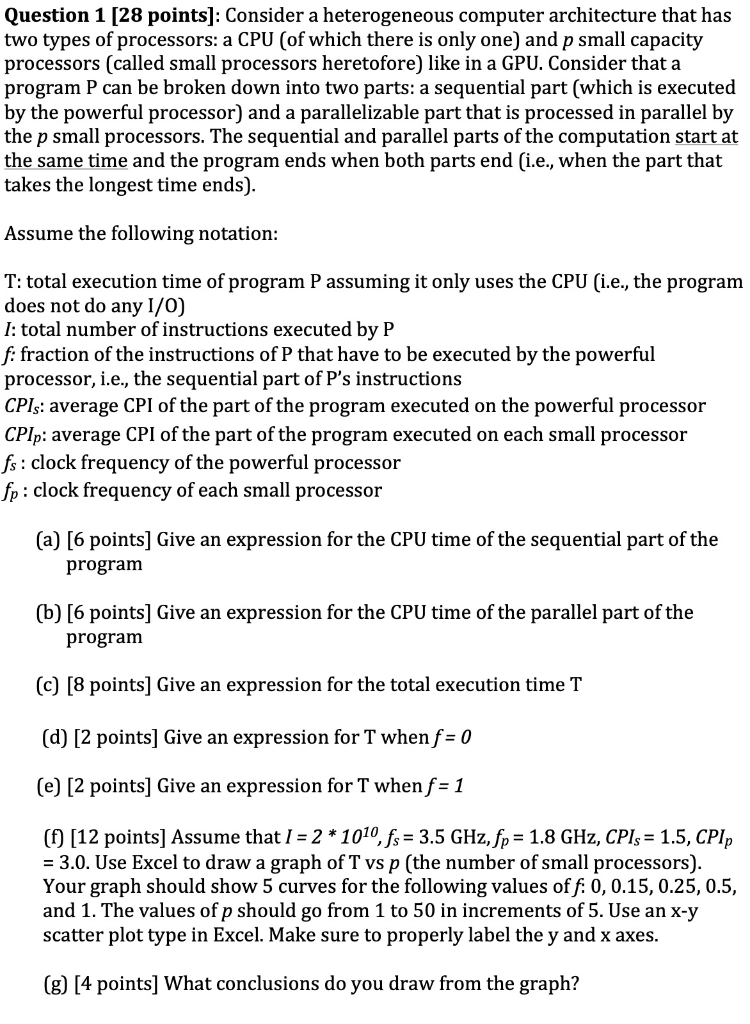
Question 1 (28 points]: Consider a heterogeneous computer architecture that has two types of processors: a CPU (of which there is only one) and p small capacity processors (called small processors heretofore) like in a GPU. Consider that a program P can be broken down into two parts: a sequential part (which is executed by the powerful processor) and a parallelizable part that is processed in parallel by the p small processors. The sequential and parallel parts of the computation start at the same time and the program ends when both parts end i.e., when the part that takes the longest time ends). Assume the following notation: T: total execution time of program P assuming it only uses the CPU (i.e., the program does not do any 1/0) I: total number of instructions executed by P f: fraction of the instructions of P that have to be executed by the powerful processor, i.e., the sequential part of P's instructions CPIs: average CPI of the part of the program executed on the powerful processor CPIp: average CPI of the part of the program executed on each small processor fs: clock frequency of the powerful processor fp:clock frequency of each small processor (a) [6 points Give an expression for the CPU time of the sequential part of the program (b) [6 points] Give an expression for the CPU time of the parallel part of the program (C) [8 points] Give an expression for the total execution time T (d) [2 points] Give an expression for T when f = 0 (e) [2 points] Give an expression for T when f = 1 (f) (12 points) Assume that I = 2 * 1010, fs = 3.5 GHz, fp = 1.8 GHz, CPI, = 1.5, CPI = 3.0. Use Excel to draw a graph of T vs p (the number of small processors). Your graph should show 5 curves for the following values of f: 0, 0.15, 0.25, 0.5, and 1. The values of p should go from 1 to 50 in increments of 5. Use an x-y scatter plot type in Excel. Make sure to properly label the y and x axes. (g) [4 points] What conclusions do you draw from the graph? Question 1 (28 points]: Consider a heterogeneous computer architecture that has two types of processors: a CPU (of which there is only one) and p small capacity processors (called small processors heretofore) like in a GPU. Consider that a program P can be broken down into two parts: a sequential part (which is executed by the powerful processor) and a parallelizable part that is processed in parallel by the p small processors. The sequential and parallel parts of the computation start at the same time and the program ends when both parts end i.e., when the part that takes the longest time ends). Assume the following notation: T: total execution time of program P assuming it only uses the CPU (i.e., the program does not do any 1/0) I: total number of instructions executed by P f: fraction of the instructions of P that have to be executed by the powerful processor, i.e., the sequential part of P's instructions CPIs: average CPI of the part of the program executed on the powerful processor CPIp: average CPI of the part of the program executed on each small processor fs: clock frequency of the powerful processor fp:clock frequency of each small processor (a) [6 points Give an expression for the CPU time of the sequential part of the program (b) [6 points] Give an expression for the CPU time of the parallel part of the program (C) [8 points] Give an expression for the total execution time T (d) [2 points] Give an expression for T when f = 0 (e) [2 points] Give an expression for T when f = 1 (f) (12 points) Assume that I = 2 * 1010, fs = 3.5 GHz, fp = 1.8 GHz, CPI, = 1.5, CPI = 3.0. Use Excel to draw a graph of T vs p (the number of small processors). Your graph should show 5 curves for the following values of f: 0, 0.15, 0.25, 0.5, and 1. The values of p should go from 1 to 50 in increments of 5. Use an x-y scatter plot type in Excel. Make sure to properly label the y and x axes. (g) [4 points] What conclusions do you draw from the graph







